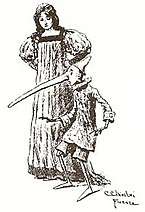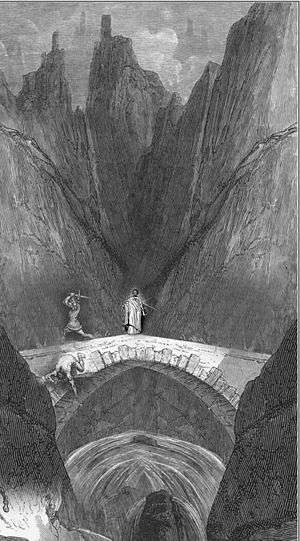Barbershop paradox
The barbershop paradox was proposed by Lewis Carroll in a three-page essay titled "A Logical Paradox", which appeared in the July 1894 issue of Mind. The name comes from the "ornamental" short story that Carroll uses to illustrate the paradox (although it had appeared several times in more abstract terms in his writing and correspondence before the story was published). Carroll claimed that it illustrated "a very real difficulty in the Theory of Hypotheticals" in use at the time.[1] Modern logicians would not regard it as a paradox but simply as a logical error.
The paradox
Briefly, the story runs as follows: Uncle Joe and Uncle Jim are walking to the barber shop. There are three barbers who live and work in the shop—Allen, Brown, and Carr—but not all of them are always in the shop. Carr is a good barber, and Uncle Jim is keen to be shaved by him. He knows that the shop is open, so at least one of them must be in. He also knows that Allen is a very nervous man, so that he never leaves the shop without Brown going with him.
Uncle Joe insists that Carr is certain to be in, and then claims that he can prove it logically. Uncle Jim demands the proof. Uncle Joe reasons as follows.
Suppose that Carr is out. If Carr is out, then if Allen is also out Brown would have to be in, since someone must be in the shop for it to be open. However, we know that whenever Allen goes out he takes Brown with him, and thus we know as a general rule that if Allen is out, Brown is out. So if Carr is out then the statements "if Allen is out then Brown is in" and "if Allen is out then Brown is out" would both be true at the same time.
Uncle Joe notes that this seems paradoxical; the two "hypotheticals" seem "incompatible" with each other. So, by contradiction, Carr must logically be in.
However, the correct conclusion to draw from the incompatibility of the two "hypotheticals" is that what is hypothesised in them (that Allen is out) must be false under our assumption that Carr is out. Then our logic simply allows us to arrive at the conclusion "If Carr is out, then Allen must necessarily be in".
Simplification
Carroll wrote this story to illustrate a controversy in the field of logic that was raging at the time. His vocabulary and writing style can easily add to the confusion of the core issue for modern readers.
Notation
When reading the original it may help to keep the following in mind:
- What Carroll called "hypotheticals" modern logicians call "logical conditionals".
- Uncle Joe concludes his proof reductio ad absurdum, meaning in English "proof by contradiction".
- What Carroll calls the protasis of a conditional is now known as the antecedent, and similarly the apodosis is now called the consequent.
Symbols can be used to greatly simplify logical statements such as those inherent in this story:
| Operator (Name) | Colloquial | Symbolic | ||
|---|---|---|---|---|
| Negation | NOT | not X | ¬ | ¬X |
| Conjunction | AND | X and Y | ∧ | X ∧ Y |
| Disjunction | OR | X or Y | ∨ | X ∨ Y |
| Conditional | IF ... THEN | if X then Y | ⇒ | X ⇒ Y |
Note: X ⇒ Y (also known as "Implication") can be read many ways in English, from "X is sufficient for Y" to "Y follows from X". (See also Table of mathematical symbols.)
Restatement
To aid in restating Carroll's story more simply, we will take the following atomic statements:
- A = Allen is in the shop
- B = Brown is in
- C = Carr is in
So, for instance (¬A ∧ B) represents "Allen is out and Brown is in"
Uncle Jim gives us our two axioms:
- There is at least one barber in the shop now (A ∨ B ∨ C)
- Allen never leaves the shop without Brown (¬A ⇒ ¬B)
Uncle Joe presents a proof:
| Abbreviated English with logical markers | Mainly Symbolic |
|---|---|
| Suppose Carr is NOT in. | H0: ¬C |
| Given NOT C, IF Allen is NOT in THEN Brown must be in, to satisfy Axiom 1(A1). | By H0 and A1, ¬A ⇒ B |
| But Axiom 2(A2) gives that it is universally true that IF Allen is Not in THEN Brown is Not in (it's always true that if ¬A then ¬B) |
By A2, ¬A ⇒ ¬B |
| So far we have that NOT C yields both (Not A THEN B) AND (Not A THEN Not B). | Thus ¬C ⇒ ( (¬A ⇒ B) ∧ (¬A ⇒ ¬B) ) |
| Uncle Joe claims that these are contradictory. | ⊥ |
| Therefore, Carr must be in. | ∴C |
Uncle Joe basically makes the argument that (¬A ⇒ B) and (¬A ⇒ ¬B) are contradictory, saying that the same antecedent cannot result in two different consequents.
This purported contradiction is the crux of Joe's "proof." Carroll presents this intuition-defying result as a paradox, hoping that the contemporary ambiguity would be resolved.
Discussion
In modern logic theory this scenario is not a paradox. The law of implication reconciles what Uncle Joe claims are incompatible hypotheticals. This law states that "if X then Y" is logically identical to "X is false or Y is true" (¬X ∨ Y). For example, given the statement "if you press the button then the light comes on", it must be true at any given moment that either you have not pressed the button, or the light is on.
In short, what obtains is not that ¬C yields a contradiction, only that it necessitates A, because ¬A is what actually yields the contradiction.
In this scenario, that means Carr doesn't have to be in, but that if he isn't in, Allen has to be in.
Simplifying to Axiom 1
Applying the law of implication to the offending conditionals shows that rather than contradicting each other one simply reiterates the fact that since the shop is open one or more of Allen, Brown or Carr is in and the other puts very little restriction on who can or cannot be in shop.
To see this let's attack Jim's large "contradictory" result, mainly by applying the law of implication repeatedly. First let's break down one of the two offending conditionals:
|
|
Substituting this into
|
|
Which yields, with continued application of the law of implication,
|
|
- note that : C ∨ ( (A ∨ B) ∧ (A ∨ ¬B) ) can be simplified to C ∨ A
- since ( (A ∨ B) ∧ (A ∨ ¬B) ) is simply A
And finally, (on the right we are distributing over the parentheses)
|
|
So the two statements which become true at once are: "One or more of Allen, Brown or Carr is in," which is simply Axiom 1, and "Carr is in or Allen is in or Brown is out." Clearly one way that both of these statements can become true at once is in the case where Allen is in (because Allen's house is the barber shop, and at some point Brown left the shop).
Another way to describe how (X ⇒ Y) ⇔ (¬X ∨ Y) resolves this into a valid set of statements is to rephrase Jim's statement that "If Allen is also out ..." into "If Carr is out and Allen is out then Brown is in" ( (¬C ∧ ¬A) ⇒ B).
Showing conditionals compatible
The two conditionals are not logical opposites: to prove by contradiction Jim needed to show ¬C ⇒ (Z ∧ ¬Z), where Z happens to be a conditional.
The opposite of (A ⇒ B) is ¬(A ⇒ B), which, using De Morgan's Law, resolves to (A ∧ ¬B), which is not at all the same thing as (¬A ∨ ¬B), which is what A ⇒ ¬B reduces to.
This confusion about the "compatibility" of these two conditionals was foreseen by Carroll, who includes a mention of it at the end of the story. He attempts to clarify the issue by arguing that the protasis and apodosis of the implication "If Carr is in ..." are "incorrectly divided." However, application of the Law of Implication removes the "If ..." entirely (reducing to disjunctions), so no protasis and apodosis exist and no counter-argument is needed.
See also
Notes
- ↑ Carroll, Lewis (July 1894). "A Logical Paradox". Mind. 3 (11): 436–438.
Further reading
- Russell, Bertrand (1903). "Chapter II. Symbolic Logic". The Principles of Mathematics. p. § 19 n. 1. ISBN 0-415-48741-2. Russell suggests a truth-functional notion of logical conditionals, which (among other things) entails that a false proposition will imply all propositions. In a note he mentions that his theory of implication would dissolve Carroll's paradox, since it not only allows, but in fact requires that both "p implies q" and "p implies not-q" be true, so long as p is not true.


